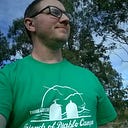Steel
The Australian Government Department of Industry, Innovation and Science recently hosted a public webinar for proponents and opponents of the national radioactive manangement process to discuss the progress so far.
The whole discussion is worth watching. Take careful note as the participants who aren’t, in some form, anti-nuclear take the time to clearly deconstruct many of the usual arguments presented against moving ahead with the process, the proposed facility, and nuclear technology in general, to reveal the underlying falacies and contradictions — only to hear some of these arguments nevertheless stated later by the others, as if reciting from a script.
On what seems to be a tangent, Dr Ben Heard, who is the founder of Bright New World and consulted diligently with the site selection process early on, says:
There’s a term that’s coming up these days called ‘steel-manning’, and it’s the opposite of straw-manning. A straw-man is where you put up a nonsense argument of someone else’sposition only to tear it down, and everyone’s very familiar with doing that and it’s really, really unhelpful.
The opposite of that is steel-manning, where, say, I can present the position of someone who disagrees with me, in a way that they themselves would say “yes, that is a fair representation of my position. I think you’ve represented me and my position fairly.”
Even though it’s not my position.
So, let me attempt to steel-man the anti-nuclear position with respect to this effort:
“Helping the management of radioactive waste proceed is equivalent to encouraging the use of nuclear weapons against human populations.”
It’s understandable if this strikes anyone as going a bit far, but please compare it to this answer at timestamp 33:18 of this similarly enlightening episode of ABC Radio National’s The People vs.
In the same vein, the anti-nuclear campaign should be encouraged to build a steel-man on this issue. Let me quote Dr Adi Patterson, CEO of ANSTO, for inspiration:
I personally have a greater vision for the radioactive waste management facility. That vision includes adapting it into a scientific mission, to work with the local communities on the application of nuclear techniques for agriculture, for the environment, and for the better understanding of the place in which it is located.
We’ve already had some excellent discussions and are already talking, for example, with the wheat farmers about how partnerships with universities, partnerships with a facility, and partnerships with ANSTO could lead to a new growth of knowledge around the application of micro fertilizers, for example. That is the type of relationship you would expect a federal facility to have with its local community.
So I think that the assumption that this is some sort of concrete box in which waste is put away is not an appropriate model; this is a people-centric model, it’s a community-centric model where you can build layers of meaning from the original and historic use of those those wasteforms and the benefits they created, all the way back to benefits in those communities, that accumulate because of the science. So I see no reason that this facility won’t take on additional mandates over time and become an iconic facility that is globally respected.
That most certainly isn’t a cheap shot.
Oscar Archer holds a PhD in chemistry and has been analysing energy issues for 13 years, focusing on nuclear technology for 4, with a background in manufacturing and QA. By day he works in energy efficiency research & development. He helps out at Adelaide-based Bright New World as Senior Advisor. Find him @OskaArcher on Twitter.
